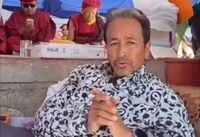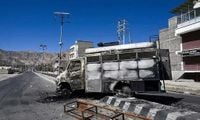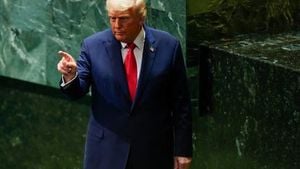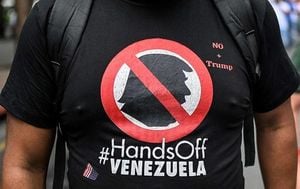On Friday, September 26, 2025, the Himalayan territory of Ladakh was thrust into the national spotlight as Indian police arrested Sonam Wangchuk, a prominent activist, engineer, and environmental reformer. His detention, coming just two days after violent protests erupted in Leh, has intensified an already volatile situation in a region long fraught with political tension and calls for greater autonomy.
The protests on Wednesday, September 24, 2025, marked one of the bloodiest days in Ladakh’s recent history. According to Reuters, angry crowds torched buildings and police vehicles in Leh, the region’s main city, as demonstrators—many of them young—clashed with security forces. Police responded with live fire, resulting in at least four deaths and dozens of injuries, including among police and security personnel. Some outlets, such as AFP, reported the death toll as high as five. Authorities claimed the use of force was in self-defense.
Sonam Wangchuk, who had been on a 14-day hunger strike to demand statehood and constitutional protections for Ladakh, ended his fast after the violence broke out. The Indian interior ministry swiftly accused him of inciting the unrest through “provocative statements,” and canceled the license of his well-known non-governmental organization, the Students’ Educational and Cultural Movement of Ladakh (SECMOL). His arrest came just before he was scheduled to address a press conference, with police detaining him at his village of Uley Tokpo. As of Friday, authorities had not disclosed the formal charges against him.
In response to the unrest, the government imposed a curfew in several parts of Ladakh, including Leh and Kargil, and suspended mobile internet services across the region. Public gatherings were restricted to groups of five, and the streets of Leh were left eerily quiet as armed forces patrolled the city. According to CNBC-TV18, the Home Ministry specifically accused Wangchuk of instigating violence among Ladakh’s youth.
Wangchuk, however, has categorically denied these allegations. Speaking to The Hindu, he lamented, “It is as sad as the incident itself, the way they are dealing with the issue in a childish way,” adding that authorities were trying to make him a “scapegoat.” He continued, “This is not the way to heal a wound. It will further aggravate the situation, it will further anger the youth. After doing all this to us—for six years of joblessness, of unmet promises—they are now just blaming me for everything.”
The protests that swept through Ladakh this week were not a sudden outburst, but rather the latest chapter in a long campaign for statehood and constitutional protections under the Sixth Schedule—provisions that would grant Ladakh greater autonomy and allow its tribal communities to shape their own laws and policies. Since 2019, when Prime Minister Narendra Modi’s government stripped Ladakh of its regional autonomy by separating it from Jammu and Kashmir and placing it under direct federal rule, local resentment has simmered. The government had promised to include Ladakh in the Sixth Schedule, but that promise remains unfulfilled.
Wangchuk’s activism is deeply rooted in Ladakh’s unique challenges. An engineer by training, he is internationally recognized for his work in education and climate innovation. He invented the Ice Stupa, an artificial glacier designed to store water in the arid trans-Himalayan region, and in 1988, he founded SECMOL to reform government schools in Ladakh. His environmental work earned him the prestigious Ramon Magsaysay Award in 2018, and his life even inspired a character in the popular Bollywood film Three Idiots.
For the past six years, Ladakh’s civic bodies, including the Leh Apex Body and the Kargil Democratic Alliance, have led peaceful marches, hunger strikes, and other forms of protest. Their demands are straightforward: statehood, job quotas for local people, special constitutional status, and the power to elect their own local government. According to Al Jazeera, these groups have been in talks with the federal government since 2023, with the next round of negotiations set for October 6, 2025.
But the events of this week have raised the stakes. As the situation in Ladakh spiraled, candlelight vigils sprang up in New Delhi and other cities, with supporters from the Aam Aadmi Party (AAP) and other groups demanding Wangchuk’s release. Photos circulated of demonstrators holding placards and lighting candles, a poignant reminder of the deep well of support he commands across India.
Wangchuk’s arrest has also drawn international attention. Pakistan’s Foreign Office condemned the Indian authorities’ handling of the protests, calling the developments “extremely disturbing” and a manifestation of what it described as India’s “iron-fisted approach” in the disputed territory, according to Dawn. The region’s strategic importance is underscored by its proximity to both China and Pakistan; in 2020, Indian and Chinese troops clashed in Ladakh’s disputed border areas, resulting in casualties on both sides.
The central government’s response to the unrest has sparked debate about its approach to dissent. Critics argue that targeting Wangchuk and his NGO is an attempt to silence the movement rather than address the root causes of local frustration: joblessness, lack of political representation, and environmental concerns. Supporters of the government, on the other hand, insist that law and order must be maintained and that no one is above the law, regardless of their reputation or achievements.
As Ladakh braces for the next round of talks with the federal government, uncertainty hangs in the air. Will the authorities engage meaningfully with local leaders and address longstanding grievances, or will the crackdown on dissent deepen the region’s sense of alienation? The coming weeks may prove decisive—not just for Ladakh’s future, but for the broader question of how India manages its diverse and restive regions.
For now, the streets of Leh remain under curfew, the internet is dark, and a celebrated activist sits behind bars. The world watches, waiting to see whether Ladakh’s cry for autonomy will be met with dialogue or further repression.






